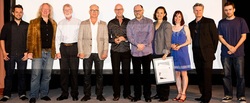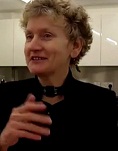 Australian Editors Celebrating the 2013 Ellie Awards
Australian Editors Celebrating the 2013 Ellie Awards Anyway, I've always felt an affinity with editors and it's often occurred to me that my work on how to structure complex films would be of use to them. I've kept meaning to make contact with their organisations but haven't. Interestingly, I've recently started to get screen editors contacting me, saying that my work as explained in my books is of a lot of use. Which is great.
So now that I'm about to give a couple of 2-day seminars in Australia, I thought I'd get the ball rolling and make a special effort to reach screen editors. Hence, I'm writing a post here specifically for screen editors in Australia. This way they'll get to hear about what I do and, if they think it worth it, they can attend one of the two Australian seminars, which are hosted by the Australian National Film School in (Sydney 22-23 Feb, Melbourne 1-2 March. These seminars are entitled 'New Structures in Screenwriting.'
For enrolments and further information
I hope other editors around the world will also find it useful.
My article for the Australian Screen Editors' Guild
My name is Linda Aronson and I am what’s commonly known as a screenwriting guru (horrible term). I teach and consult all over the world and I am about to give two 2-day seminars in Australia hosted by AFTRS for writers, directors and producers in film, TV and documentary (Sydney 22-23 Feb, Melbourne 1-2 March
The topic is New Structures in Screenwriting, that is, how to construct and fix complex story structures, including how to use nonlinear stories to fix problem films and TV works. I’m writing this article for the ASE newsletter because there wasn’t enough time to organize a talk for you and I think screen editors in Australia, like their colleagues in the USA and UK might find my ideas useful. Thanks for giving me space here. I’m afraid this article can be only an introduction because the material is complex, indeed, in the seminar I refer to more than 80 films. In Germany my seminars usually run five days, so you can see we cover a lot and keep a cracking pace.
Complex story structures
What I mean by complex story structures are films, TV, documentaries and cross-media projects that involve elements like flashbacks, multiple storylines, fractured storylines (along the lines of Pulp Fiction or 21 Grams or Amores Perros), and ensembles of various kinds. I refer to this sort of thing by the umbrella term: ‘parallel narrative’.
While parallel narrative is everywhere these days in film and TV, surprisingly (and I continue to find it surprising) I’m the only ‘guru’ to properly isolate and provide any practical assistance on constructing these parallel narrative forms. The prevailing wisdom is that the only type of structure is ‘one hero on a single linear chronological journey’. I think the one-hero-three-act chronological model is excellent for some stories, and forms the basis of the parallel narrative forms, but it’s clearly not the only structure. I think there are at present six main families of parallel narrative, all with subcategories, meanwhile, hybrids are occurring all the time. For example, an interesting hybrid is Eternal Sunshine of the Spotless Mind, which employs two different types of parallel narrative. It has a flashback story about the lovers Joel and Clementine which spans the past and enters the present, and another story, a group story in the present that runs alongside the flashback story, about the people in Lacuna company.
In my seminars I explain each type of parallel narrative works to clear patterns based on multiplying, and/or fracturing and truncating the chronological three act structure in very specific and predictable ways. The patterns are so clear and so common in films from all cultures that we can use the patterns as templates. Why am I so sure? Well, quite simply, the patterns and rules are present when the films work. They’re not present when the films don’t work. Want to create a structure like Eternal Sunshine? I think I can show you how.
If you want greater detail, my book The 21st Century Screenplay goes into all of this in a very detailed way. My books are required reading at NYU, Berkeley and many leading film schools around the world, with Polish and Czech translations in the pipeline, so people get something out of them. You can also check out some videos and get further written information in the section on practical writing advice You can also sign up for my newsletter in which I write more on parallel narrative (and yes, I really should get a life, shouldn't I). Meanwhile, here is a quick tour of my theories.
Understanding parallel narrative
If screenwriting experts talk about flashbacks and Pulp Fiction structures and multiple storylines and the other contents of parallel narrative at all, you’ll normally find they discuss them merely as ingredients that can be added as optional extras to the three act linear structure. Not so.
The key to understanding how to work with parallel narrative is a) that each family is a structure in its own right, with specific rules and patterns, and b) content dictates which structure you use.
Everything depends what story you want to tell. It’s entirely valid to tell the story of a group, not just an individual. It’s clear that flashback films from Citizen Kane to Blue Jasmine are fascinating and benefit greatly from actually depicting on screen stories from the past, not just talking about the past in the present (as you would need to do were you to use the conventional one hero, one time frame model). Similarly we enjoy fractured multiple storyline films like Pulp Fiction and 21 Grams that make their point through several stories, not just one.
Here is a quick summary of the six main types of parallel narrative, each of which has several sub categories, along with a quick look at how you structure them and what problems you’ll face as you begin to structure them yourself. The names may sound clumsy but I have deliberately invented them so that they actually describe the shape of the structure, thereby being a reminder of what the structure actually is and does.
Different families of parallel narrative
1. Tandem Narrative. Films in this form have equally-weighted stories on the same theme running simultaneously (e.g. City of Hope, Caramel, Lantana, Traffic – practically everything of Altman’s)
2. Multiple protagonist films (e.g. American Beauty, Little Miss Sunshine, Saving Private Ryan, Galaxy Quest, Tea with Mussolini, Ordinary People, The Full Monty, All About my Mother etc.). Multiple protagonist films work by being either missions, reunions or physical or emotional sieges (you may have to invent and insert one of these)
3. Double Journeys These are films like The Departed, Brokeback Mountain, Finding Nemo, and The Lives of Others, in which there are two equally important protagonists who are journeying either towards, apart or in parallel with each other physically, emotionally or both.
4. Flashback. There are six subcategories of flashback some very simple, others very complex each serving a different story purpose. Sometimes films will have several kinds. I explain many flashback films across all categories, including Blue Jasmine, Usual Suspects, Annie Hall, Citizen Kane, The Life of David Gale, Shine, Remains of the Day, Slumdog Millionaire, Great Gatsby, Shine, Remains of the Day, Slumdog Millionaire, Life of Pi, Benjamin Button, Catch-22 etc.
5. Consecutive Stories (I used to call this family 'Sequential Narrative') This means equally-weighted, self-contained stories following one after the other joined together in some way at the end (e.g. Pulp Fiction, The Circle, The Butterfly Effect, Run Lola Run, Amores Perros, City of God ). These films split into a number of categories with different structural rules.
6. Fractured Tandem. This is the form of films like 21 Grams, Babel, Three Burials of Melchiades Estrada, The Hours and Crash. It’s like tandem but fractured. It consists of equally-weighted stories, often in different time frames, fractured and truncated and put together again, usually dealing with catastrophic encounters.
Problems: Pace, Connection, Meaning and Closure
Audiences are brutal if your parallel narrative film is confusing or anticlimactic and you don’t give them a clear reason for watching a parallel narrative structure. Once you start using multiple storylines and fracturing you will be faced with major problems about how to jump stories without losing pace and coherence. You also need to answer the obvious audience question: ‘why these particular stories, what’s your point?’ In practice it requires you to provide pace, connection, meaning and closure – the latter being, if you like ‘a moral’, even if your ‘moral’ is that there are no answers. You also have the practical problem of squeezing many stories into 100-120 minutes, not just one main action line and one relationship subplot, so you need to condense and use truncation.
The structural patterns in all parallel narrative achieve pace, connection, meaning and closure by the following methods, which we’ll look at in detail over two days:
1. Jumping storylines in specific ways and at specific points (don’t do this and it will cause confusion, loss of pace and anti-climax.
2. Incorporating a whole range of ingredients that provide the vital connection between stories, including specific types of plot.
3. Keeping the stories differentiated to avoid confusion
4. Truncating storylines and inferring time jumps in a range of ways
The bottom line is that this stuff is not easy. However it works to patterns that you can use as templates. You do, though, need to be clear on what the templates are, which form suits which content and particularly, what can go wrong.
How editors can use my theories
As editors, you will often be asked to insert flashbacks or consider fracturing. There are ways to make this work well and ways to fall flat on your face, and in some cases you will simply not have the right footage to create a successful model with no way of getting it. But often you will. Often the difference between success and failure depends on jumping stories at the right point.
As for non scripted forms, I’m a writer, not an editor, but I would say that there is no reason why, if you have the right footage, you couldn’t turn the material into a Pulp Fiction style structure, or a flashback structure using the guidelines I’ll show you. I also think you might be interested in my suggestions for using nonlinearity to hold together and insert jeopardy into predictable films and genres. For example, in my seminar I explain how and why in my view, Syriana could have been edited in such a way as to remove a lot of its problems.
As I say, nobody can claim this stuff is easy, but, excitingly, it is definitely doable. Frankly I don’t think any of us will have a career in ten years time unless we can handle it with some degree of confidence because it is everywhere in film and TV. Of course, you can do this intuitively, but it’s risky and time consuming. I’d suggest that you check out my ideas and make up your own mind.
I hope you’ve enjoyed this taste of what I do. I’d love to see you at the seminar. I would love your specialized feedback too, since I’m only a writer, not an editor. Thanks again for the space to talk to you. The nice photo of Australian editors above comes from the ASE website.
Linda Aronson www.lindaaronson.com
New Structures in Screenwriting. Sydney 22-23 Feb, Melbourne 1-2 March
Information and Enrolments
 RSS Feed
RSS Feed


